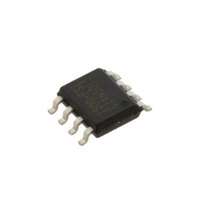CS1600-FSZ Cirrus Logic Inc, CS1600-FSZ Datasheet - Page 8

CS1600-FSZ
Manufacturer Part Number
CS1600-FSZ
Description
IC PFC CONTROLLER DCM 8SOIC
Manufacturer
Cirrus Logic Inc
Series
EXL Core™r
Specifications of CS1600-FSZ
Package / Case
8-SOIC (3.9mm Width)
Mode
Discontinuous Conduction (DCM)
Frequency - Switching
66kHz
Current - Startup
68µA
Voltage - Supply
7.9 V ~ 17 V
Operating Temperature
-40°C ~ 125°C
Mounting Type
Surface Mount
Maximum Power Dissipation
600 mW
Maximum Operating Temperature
+ 125 C
Mounting Style
SMD/SMT
Minimum Operating Temperature
- 40 C
Lead Free Status / RoHS Status
Lead free / RoHS Compliant
Lead Free Status / RoHS Status
Lead free / RoHS Compliant, Lead free / RoHS Compliant
Other names
598-1801
Available stocks
Company
Part Number
Manufacturer
Quantity
Price
Company:
Part Number:
CS1600-FSZ
Manufacturer:
CIRRUS
Quantity:
100
5. GENERAL DESCRIPTION
The CS1600 offers numerous features, options, and
functional capabilities to the designer of switching power
converters. This digital PFC control IC is designed to replace
legacy analog PFC controllers with minimal design effort.
5.1 PFC Operation
One key feature of the CS1600 is its operating frequency
profile. Figure 11 illustrates how the frequency varies over half
cycle of the line voltage in steady-state operation. When
power is first applied to the CS1600, it examines the line
voltage and adapts its operating frequency to the line voltage
as shown in Figure 11. The operating frequency is varied from
the peak to the trough of the AC input. During start-up the
control algorithm’s goal is to generate maximum power while
maintaining DCM operation, providing an approximate
square-wave envelop current within every half line cycle by
adjusting the operating frequency for fast startup behavior.
Figure 12 illustrates how the operating frequency (as a
percentage of maximum frequency) changes with output
power and the peak of the line voltage.
When P
(See 5.3 Burst Mode on page 8).
8
Figure 12. Max Switching Frequency vs. Output Power
Figure 11. Switching Frequency vs. Phase Angle
120
100
o
80
60
40
20
falls below 5% the CS1600 changes to Burst Mode
0
0
70
60
56
50
48
40
20
0
Switching Freq. (% of Max.)
Rectified Line Voltage Phase (Deg.)
5
45
20
Line Voltage (% of Max.)
Vin > 156 VAC
Vin < 182 VAC
% P
40
90
O max
60
135
80
100
180
5.2 Start-up vs. Normal Operation Mode
CS1600 has two discrete operation modes: Start-up and
Normal. Start-up mode will be activated when V
90% of nominal value and remains active until V
100% of nominal value, as shown in Figure 13. Startup mode
is activated during initial system power-up. Any V
less than 90% of nominal value, such as load change, can
cause the system to enter Start-up mode until V
back into regulation.
Startup mode is defined as a surge of current delivering
maximum power to the output regardless of the load. During
every active switch cycle, the 'ON' time is calculated to drive a
constant peak current over the entire line cycle. However, the
'OFF' time is calculated based on the DCM/CCM boundary
equation.
5.3 Burst Mode
Burst mode is utilized to improve system efficiency when the
system output power (P
implemented by intermittently disabling the PFC over a full
half-line period cycle under light load conditions, as shown in
Figure 14.
100%
90%
V
[V]
link
V
[V]
[W]
P
in
o
Figure 13. Start-up and Normal Modes
Figure 14. Burst Modes
V
in
Normal
Mode
Burst Threshold
o
) is < 5% of nominal. Burst mode is
Burst Mode
Disable
PFC
Active
Normal
Mode
t [ms]
t [ms]
CS1600
link
FET
link
V
t [ms]
link
gs
is less than
link
DS904F1
is brought
reaches
drop to




















